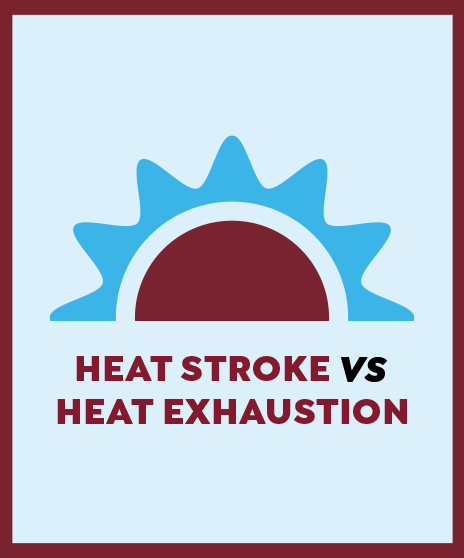Heat-related illnesses, such as heat exhaustion and heat stroke, are very common during the dog days of summer. An estimated 618 deaths occur every year due to extreme heat exposure in the United States alone.
That is why it is so important for people to learn to prevent and recognize signs and symptoms of heat-related illnesses.
What is considered a heat-related illness?
Heat-related illnesses occur when a body is exposed to extreme heat and is unable to properly cool itself down fast enough. As a result, damage to the brain and other vital organs may occur.
Heat exhaustion occurs after being exposed to extreme heat for several days, without adequate replacement of fluids. It is a milder form of heat-related illness, but if left untreated, may progress to heat stroke.
Signs and symptoms of heat exhaustion include:
- Heavy sweating
- Fast and weak pulses
- Paleness
- Fast and shallow breathing
- Muscle cramps
- Tiredness
- Weakness
- Dizziness
- Headache
- Nausea and/or vomiting
- Fainting
If these symptoms occur, and worsen, or last longer than one hour, seek medical attention immediately.
What are the signs and symptoms of a heat stroke?
The most serious type of heat-related illness is heat stroke. This occurs when the body’s temperature rises too fast, and the body’s ability to cool itself down through sweating fails.
If the body’s temperature rises to 106 degrees Fahrenheit or more within minutes, it may result in death or permanent disability if not treated immediately.
Signs and symptoms of heat stroke include:
- Body temperature above 103 degrees Fahrenheit
- Hot, red skin without sweating
- Fast, strong pulse
- Throbbing headache
- Dizziness
- Nausea
- Confusion
- Unconsciousness
Immediate medical assistance is needed if any of these occur. If you witness an individual with these signs and symptoms, get medical assistance as soon as possible, monitor the victim’s temperature (if possible), safely move the victim to a shady area, and cool the victim down with cool water.
How can I avoid heat-related illness?
To avoid heat-related illnesses, it is important to keep cool by staying in air-conditioned places as much as possible, wearing loose, light-weight clothing, taking cool showers/baths, and not engaging in very strenuous activities.
Wearing sunscreen is also very important, as sunburns affects the body’s ability to cool down. Never leave anyone in warm vehicles, either, even if the window is cracked open.
It is equally important to stay hydrated. Avoid very sugary or alcoholic drinks. For heavy sweating, sports drinks are appropriate to replace salt and mineral loss.
Older adults, infants, children, people with multiple chronic medical conditions, athletes, outdoor workers, and lower income groups are the most vulnerable to suffering heat-related illnesses, according to the Centers for Disease Control and Prevention.
So, if you or one of your loved ones fall into one of these high-risk categories, it is very important to stay hydrated and cool during days of extreme weather, and pay close attention that you and your loved ones are not already experiencing signs and symptoms of heat-related illnesses.
When planning the rest of your summer adventures, make sure you and your loved ones are prepared to beat the heat!
Reference:
Centers for Disease Control and Prevention (2019, July 19). Extreme heat.
Retrieved from https://www.cdc.gov/disasters/extremeheat/index.html

